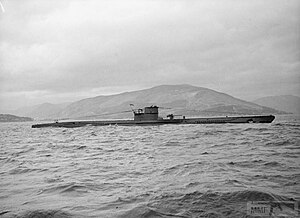
German submarine U-994

 U-570 Type VIIC submarine that was captured by the British in 1941. This U-boat is almost identical to U-994.
| |
| History | |
|---|---|
| Name | U-994 |
| Ordered | 25 May 1941 |
| Builder | Blohm & Voss, Hamburg |
| Yard number | 194 |
| Laid down | 14 November 1942 |
| Launched | 8 July 1943 |
| Commissioned | 2 September 1943 |
| Fate | Surrendered on 9 May 1945; sunk as part of Operation Deadlight on 5 December 1945 |
| General characteristics | |
| Class and type | Type VIIC submarine |
| Displacement | |
| Length |
|
| Beam |
|
| Height | 9.60 m (31 ft 6 in) |
| Draught | 4.74 m (15 ft 7 in) |
| Installed power |
|
| Propulsion |
|
| Speed |
|
| Range | |
| Test depth |
|
| Complement | 4 officers, 44–52 enlisted |
| Armament |
|
| Service record | |
| Part of: |
|
| Identification codes: | M 52 544 |
| Commanders: | |
| Operations: |
|
| Victories: | None |
German submarine U-994 was a Type VIIC U-boat of Nazi Germany's Kriegsmarine during World War II.

She was ordered on 25 May 1941, and was laid down on 14 November 1942 at Blohm & Voss, Hamburg, as yard number 194. She was launched on 8 July 1943 and commissioned under the command of Leutnant zur See Wolf Ackermann on 2 September 1943.[3]

Design
German Type VIIC submarines were preceded by the shorter Type VIIB submarines. U-994 had a displacement of 769 tonnes (757 long tons) when at the surface and 871 tonnes (857 long tons) while submerged.[4] She had a total length of 67.10 m (220 ft 2 in), a pressure hull length of 50.50 m (165 ft 8 in), a beam of 6.20 m (20 ft 4 in), a height of 9.60 m (31 ft 6 in), and a draught of 4.74 m (15 ft 7 in). The submarine was powered by two Germaniawerft F46 four-stroke, six-cylinder supercharged diesel engines producing a total of 2,800 to 3,200 metric horsepower (2,060 to 2,350 kW; 2,760 to 3,160 shp) for use while surfaced, two Garbe, Lahmeyer & Co. RP 137/c double-acting electric motors producing a total of 750 metric horsepower (550 kW; 740 shp) for use while submerged. She had two shafts and two 1.23 m (4 ft) propellers. The boat was capable of operating at depths of up to 230 metres (750 ft).[4]

The submarine had a maximum surface speed of 17.7 knots (32.8 km/h; 20.4 mph) and a maximum submerged speed of 7.6 knots (14.1 km/h; 8.7 mph).[4] When submerged, the boat could operate for 80 nautical miles (150 km; 92 mi) at 4 knots (7.4 km/h; 4.6 mph); when surfaced, she could travel 8,500 nautical miles (15,700 km; 9,800 mi) at 10 knots (19 km/h; 12 mph). U-994 was fitted with five 53.3 cm (21 in) torpedo tubes (four fitted at the bow and one at the stern), fourteen torpedoes or 26 TMA mines, one 8.8 cm (3.46 in) SK C/35 naval gun, 220 rounds, and one twin 2 cm (0.79 in) C/30 anti-aircraft gun. The boat had a complement of between 44 — 52 men.[4]

Service history
On 17 July 1944, as U-944 was returning from her first, and only, war patrol she came under attack by a Norwegian Mosquito of No. 333 (Norwegian) Squadron RAF/L. Five crewmen were wounded and the boat sustained some damage and reached Bergen later that same day.[3]

On 9 May 1945, U-994 surrendered at Trondheim, Norway. She was later transferred to Loch Ryan, Scotland on 29 May 1945. Of the 156 U-boats that eventually surrendered to the Allied forces at the end of the war, U-994 was one of 116 selected to take part in Operation Deadlight. U-994 was towed out on 5 December 1945, but foundered while under tow making her one of 55 other U-boats that sank before reaching the scuttling area.[3]

The wreck is located at 55°50′N 08°30′W / 55.833°N 8.500°W.[3]

References
- ^ Helgason, Guðmundur. "Wolf Ackermann". German U-boats of WWII - uboat.net. Retrieved 9 April 2016.
- ^ Helgason, Guðmundur. "Volker Melzer". German U-boats of WWII - uboat.net. Retrieved 9 April 2016.
- ^ a b c d Helgason, Guðmundur. "U-994". German U-boats of WWII - uboat.net. Retrieved 9 April 2016.
- ^ a b c d Gröner 1991, pp. 43–46.
External links
- Helgason, Guðmundur. "Patrols by U-994". German U-boats of WWII - uboat.net.
Bibliography
- Busch, Rainer; Röll, Hans-Joachim (1999). German U-boat commanders of World War II : a biographical dictionary. Translated by Brooks, Geoffrey. London, Annapolis, Md: Greenhill Books, Naval Institute Press. ISBN 1-55750-186-6.
- Busch, Rainer; Röll, Hans-Joachim (1999). Der U-Boot-Krieg, 1939-1945: Deutsche U-Boot-Verluste von September 1939 bis Mai 1945 [German U-boat losses from September 1939 to May 1945] (in German). Vol. IV. Hamburg, Berlin, Bonn: Mittler. ISBN 3-8132-0514-2.
- Gröner, Erich; Jung, Dieter; Maass, Martin (1991). U-boats and Mine Warfare Vessels. German Warships 1815–1945. Vol. 2. Translated by Thomas, Keith; Magowan, Rachel. London: Conway Maritime Press. ISBN 0-85177-593-4.
See what we do next...
OR
By submitting your email or phone number, you're giving mschf permission to send you email and/or recurring marketing texts. Data rates may apply. Text stop to cancel, help for help.
Success: You're subscribed now !
